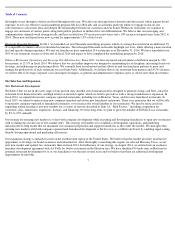El Pollo Loco 2015 Annual Report Download - page 21
Download and view the complete annual report
Please find page 21 of the 2015 El Pollo Loco annual report below. You can navigate through the pages in the report by either clicking on the pages listed below, or by using the keyword search tool below to find specific information within the annual report.
Table of Contents
At the end of fiscal 2009, we had 21 system-wide restaurants, all originally developed by franchisees, open east of the Rocky Mountains.
However, by 2012, all of these restaurants had been closed. We may encounter similar issues with our current growth strategy, which could
materially and adversely affect our business, financial condition, results of operations, and cash flow.
Due to brand recognition and logistical synergies, as part of our growth strategy, we also intend to open new restaurants in areas where we have
existing restaurants. The operating results and comparable restaurant sales for our restaurants could be adversely affected due to increasing
proximity among our restaurants and due to market saturation.
Changes in food and supply costs, especially for chicken, could adversely affect our business, financial condition, and results of operations.
Our profitability depends in part on our ability to anticipate and react to changes in food and supply costs. We are susceptible to increases in
food costs as a result of factors beyond our control, such as general economic conditions, seasonal economic fluctuations, weather conditions,
global demand, food safety concerns, infectious diseases, fluctuations in the U.S. dollar, product recalls, and government regulations. The costs
of many basic foods for humans and animals, including corn, wheat, corn flour and other flour, rice, and cooking oil, have increased markedly in
recent years, resulting in upward pricing pressures on almost all of our raw ingredients, including chicken, and increasing our food costs. Food
prices for a number of our key ingredients escalated markedly at various points in fiscal 2014 and 2013, and we expect that there will be
additional pricing pressures on some of those ingredients in fiscal 2015. Weather-related issues, such as freezes and drought, may also lead to
temporary spikes in the prices of some ingredients, such as produce and meat. Any increase in the prices of the ingredients most critical to our
menu, such as chicken, corn, cheese, avocados, beans, rice, and tomatoes, could adversely affect our operating results. Alternatively, in the event
of cost increases with respect to one or more of our raw ingredients, we might choose to temporarily suspend serving menu items, such as
guacamole or one or more of our salsas, rather than pay the increased cost. Any such changes to our available menu could negatively impact our
restaurant traffic, business, and comparable restaurant sales during the shortage and thereafter.
Our principal food product is chicken. In fiscal 2014, 2013, and 2012, the cost of chicken included in our product cost was approximately 12.6%,
13.0%, and 12.7%, respectively, of our revenue from company-operated restaurants. Material increases in the cost of chicken could materially
and adversely affect our business, operating results, and financial condition. Changes in the cost of chicken can result from a number of factors,
including seasonality, increases in the cost of grain, disease, and other factors that affect domestic and international supply of and demand for
chicken products. A major driver of the price of corn, which is the primary feed source for chicken, has been the increasing demand for corn by
the ethanol industry as an alternative fuel source, as most ethanol plants in the United States primarily use corn to make ethanol. This increased
demand on the nation’s corn crop has had and may continue to have an unfavorable impact on chicken prices. We currently do not use futures
contracts or other financial risk management strategies with respect to potential price fluctuations in the cost of chicken or other inputs, food, and
supplies, which we purchase at prevailing market or contracted prices. We have implemented menu price increases in the past to significantly
offset increased chicken prices, due to competitive pressures and compressed profit margins. We may not be able to offset all or any portion of
increased food and supply costs through higher menu prices in the future. If we implement further menu price increases in the future to protect
our margins, average check size and restaurant traffic could be materially and adversely affected, at both company-operated and franchised
restaurants.
Negative publicity could reduce sales at some or all of our restaurants.
We are, from time to time, faced with negative publicity at one or more of our restaurants relating to (i) food quality; (ii) the safety, sanitation,
and welfare of chicken, which is our principal food product; (iii) restaurant facilities; (iv) customer complaints or litigation alleging illness or
injury; (v) health inspection scores; (vi) integrity of our or our suppliers’ food processing and other policies, practices, and procedures;
(vii) employee relationships; or (viii) other matters. Negative publicity can adversely affect us, regardless of whether an allegation is valid or
17
























